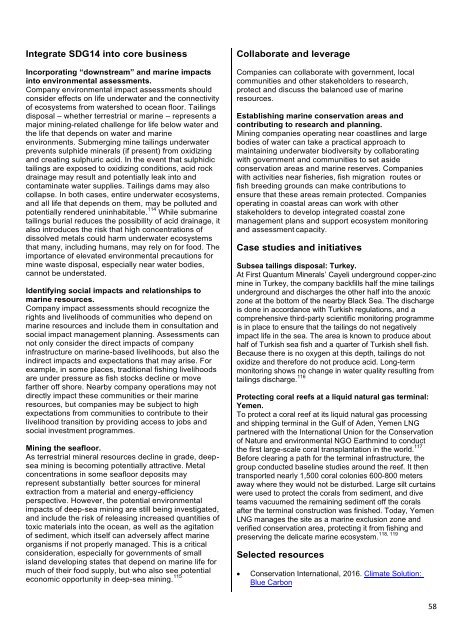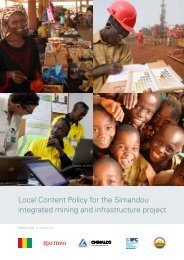Mapping Mining to the Sustainable Development Goals An Atlas
2gpArJN
2gpArJN
You also want an ePaper? Increase the reach of your titles
YUMPU automatically turns print PDFs into web optimized ePapers that Google loves.
Integrate SDG14 in<strong>to</strong> core business<br />
Incorporating “downstream” and marine impacts<br />
in<strong>to</strong> environmental assessments.<br />
Company environmental impact assessments should<br />
consider effects on life underwater and <strong>the</strong> connectivity<br />
of ecosystems from watershed <strong>to</strong> ocean floor. Tailings<br />
disposal – whe<strong>the</strong>r terrestrial or marine – represents a<br />
major mining-related challenge for life below water and<br />
<strong>the</strong> life that depends on water and marine<br />
environments. Submerging mine tailings underwater<br />
prevents sulphide minerals (if present) from oxidizing<br />
and creating sulphuric acid. In <strong>the</strong> event that sulphidic<br />
tailings are exposed <strong>to</strong> oxidizing conditions, acid rock<br />
drainage may result and potentially leak in<strong>to</strong> and<br />
contaminate water supplies. Tailings dams may also<br />
collapse. In both cases, entire underwater ecosystems,<br />
and all life that depends on <strong>the</strong>m, may be polluted and<br />
potentially rendered uninhabitable. 114 While submarine<br />
tailings burial reduces <strong>the</strong> possibility of acid drainage, it<br />
also introduces <strong>the</strong> risk that high concentrations of<br />
dissolved metals could harm underwater ecosystems<br />
that many, including humans, may rely on for food. The<br />
importance of elevated environmental precautions for<br />
mine waste disposal, especially near water bodies,<br />
cannot be understated.<br />
Identifying social impacts and relationships <strong>to</strong><br />
marine resources.<br />
Company impact assessments should recognize <strong>the</strong><br />
rights and livelihoods of communities who depend on<br />
marine resources and include <strong>the</strong>m in consultation and<br />
social impact management planning. Assessments can<br />
not only consider <strong>the</strong> direct impacts of company<br />
infrastructure on marine-based livelihoods, but also <strong>the</strong><br />
indirect impacts and expectations that may arise. For<br />
example, in some places, traditional fishing livelihoods<br />
are under pressure as fish s<strong>to</strong>cks decline or move<br />
far<strong>the</strong>r off shore. Nearby company operations may not<br />
directly impact <strong>the</strong>se communities or <strong>the</strong>ir marine<br />
resources, but companies may be subject <strong>to</strong> high<br />
expectations from communities <strong>to</strong> contribute <strong>to</strong> <strong>the</strong>ir<br />
livelihood transition by providing access <strong>to</strong> jobs and<br />
social investment programmes.<br />
<strong>Mining</strong> <strong>the</strong> seafloor.<br />
As terrestrial mineral resources decline in grade, deepsea<br />
mining is becoming potentially attractive. Metal<br />
concentrations in some seafloor deposits may<br />
represent substantially better sources for mineral<br />
extraction from a material and energy-efficiency<br />
perspective. However, <strong>the</strong> potential environmental<br />
impacts of deep-sea mining are still being investigated,<br />
and include <strong>the</strong> risk of releasing increased quantities of<br />
<strong>to</strong>xic materials in<strong>to</strong> <strong>the</strong> ocean, as well as <strong>the</strong> agitation<br />
of sediment, which itself can adversely affect marine<br />
organisms if not properly managed. This is a critical<br />
consideration, especially for governments of small<br />
island developing states that depend on marine life for<br />
much of <strong>the</strong>ir food supply, but who also see potential<br />
economic opportunity in deep-sea mining. 115<br />
Collaborate and leverage<br />
Companies can collaborate with government, local<br />
communities and o<strong>the</strong>r stakeholders <strong>to</strong> research,<br />
protect and discuss <strong>the</strong> balanced use of marine<br />
resources.<br />
Establishing marine conservation areas and<br />
contributing <strong>to</strong> research and planning.<br />
<strong>Mining</strong> companies operating near coastlines and large<br />
bodies of water can take a practical approach <strong>to</strong><br />
maintaining underwater biodiversity by collaborating<br />
with government and communities <strong>to</strong> set aside<br />
conservation areas and marine reserves. Companies<br />
with activities near fisheries, fish migration routes or<br />
fish breeding grounds can make contributions <strong>to</strong><br />
ensure that <strong>the</strong>se areas remain protected. Companies<br />
operating in coastal areas can work with o<strong>the</strong>r<br />
stakeholders <strong>to</strong> develop integrated coastal zone<br />
management plans and support ecosystem moni<strong>to</strong>ring<br />
and assessment capacity.<br />
Case studies and initiatives<br />
Subsea tailings disposal: Turkey.<br />
At First Quantum Minerals’ Cayeli underground copper-zinc<br />
mine in Turkey, <strong>the</strong> company backfills half <strong>the</strong> mine tailings<br />
underground and discharges <strong>the</strong> o<strong>the</strong>r half in<strong>to</strong> <strong>the</strong> anoxic<br />
zone at <strong>the</strong> bot<strong>to</strong>m of <strong>the</strong> nearby Black Sea. The discharge<br />
is done in accordance with Turkish regulations, and a<br />
comprehensive third-party scientific moni<strong>to</strong>ring programme<br />
is in place <strong>to</strong> ensure that <strong>the</strong> tailings do not negatively<br />
impact life in <strong>the</strong> sea. The area is known <strong>to</strong> produce about<br />
half of Turkish sea fish and a quarter of Turkish shell fish.<br />
Because <strong>the</strong>re is no oxygen at this depth, tailings do not<br />
oxidize and <strong>the</strong>refore do not produce acid. Long-term<br />
moni<strong>to</strong>ring shows no change in water quality resulting from<br />
tailings discharge. 116<br />
Protecting coral reefs at a liquid natural gas terminal:<br />
Yemen.<br />
To protect a coral reef at its liquid natural gas processing<br />
and shipping terminal in <strong>the</strong> Gulf of Aden, Yemen LNG<br />
partnered with <strong>the</strong> International Union for <strong>the</strong> Conservation<br />
of Nature and environmental NGO Earthmind <strong>to</strong> conduct<br />
<strong>the</strong> first large-scale coral transplantation in <strong>the</strong> world. 117<br />
Before clearing a path for <strong>the</strong> terminal infrastructure, <strong>the</strong><br />
group conducted baseline studies around <strong>the</strong> reef. It <strong>the</strong>n<br />
transported nearly 1,500 coral colonies 600-800 meters<br />
away where <strong>the</strong>y would not be disturbed. Large silt curtains<br />
were used <strong>to</strong> protect <strong>the</strong> corals from sediment, and dive<br />
teams vacuumed <strong>the</strong> remaining sediment off <strong>the</strong> corals<br />
after <strong>the</strong> terminal construction was finished. Today, Yemen<br />
LNG manages <strong>the</strong> site as a marine exclusion zone and<br />
verified conservation area, protecting it from fishing and<br />
118, 119<br />
preserving <strong>the</strong> delicate marine ecosystem.<br />
Selected resources<br />
<br />
Conservation International, 2016. Climate Solution:<br />
Blue Carbon<br />
58






